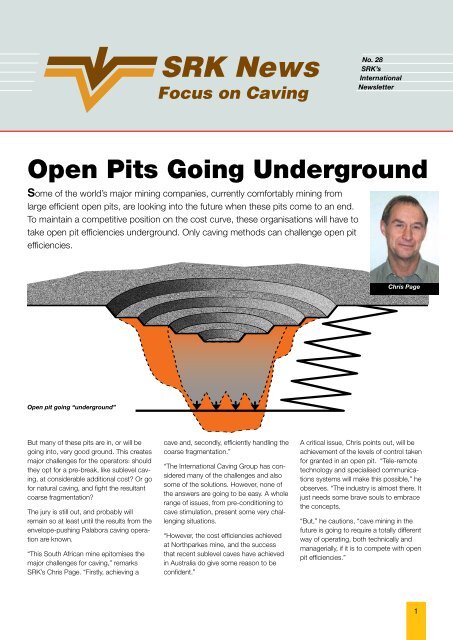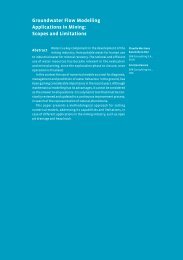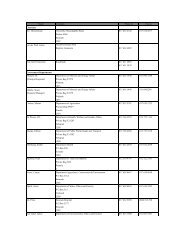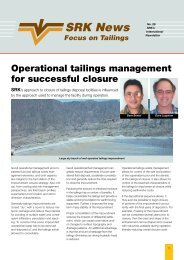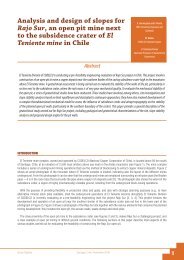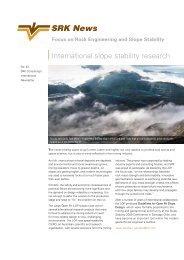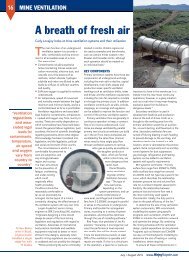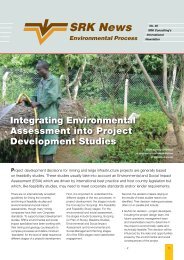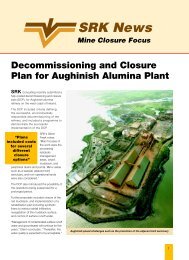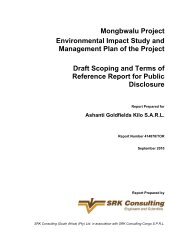Open Pits Going Underground - SRK Consulting
Open Pits Going Underground - SRK Consulting
Open Pits Going Underground - SRK Consulting
Create successful ePaper yourself
Turn your PDF publications into a flip-book with our unique Google optimized e-Paper software.
<strong>Open</strong> <strong>Pits</strong> <strong>Going</strong> <strong>Underground</strong><br />
<strong>Open</strong> pit going “underground”<br />
But many of these pits are in, or will be<br />
going into, very good ground. This creates<br />
major challenges for the operators: should<br />
they opt for a pre-break, like sublevel caving,<br />
at considerable additional cost? Or go<br />
for natural caving, and fight the resultant<br />
coarse fragmentation?<br />
The jury is still out, and probably will<br />
remain so at least until the results from the<br />
envelope-pushing Palabora caving operation<br />
are known.<br />
“This South African mine epitomises the<br />
major challenges for caving,” remarks<br />
<strong>SRK</strong>’s Chris Page. “Firstly, achieving a<br />
Focus on Caving<br />
Some of the world’s major mining companies, currently comfortably mining from<br />
large efficient open pits, are looking into the future when these pits come to an end.<br />
To maintain a competitive position on the cost curve, these organisations will have to<br />
take open pit efficiencies underground. Only caving methods can challenge open pit<br />
efficiencies.<br />
cave and, secondly, efficiently handling the<br />
coarse fragmentation.”<br />
“The International Caving Group has considered<br />
many of the challenges and also<br />
some of the solutions. However, none of<br />
the answers are going to be easy. A whole<br />
range of issues, from pre-conditioning to<br />
cave stimulation, present some very challenging<br />
situations.<br />
“However, the cost efficiencies achieved<br />
at Northparkes mine, and the success<br />
that recent sublevel caves have achieved<br />
in Australia do give some reason to be<br />
confident.”<br />
No. 28<br />
<strong>SRK</strong>’s<br />
International<br />
Newsletter<br />
Chris Page<br />
A critical issue, Chris points out, will be<br />
achievement of the levels of control taken<br />
for granted in an open pit. “Tele-remote<br />
technology and specialised communications<br />
systems will make this possible,” he<br />
observes. “The industry is almost there. It<br />
just needs some brave souls to embrace<br />
the concepts.<br />
“But,” he cautions, “cave mining in the<br />
future is going to require a totally different<br />
way of operating, both technically and<br />
managerially, if it is to compete with open<br />
pit efficiencies.”<br />
1
<strong>SRK</strong> Consultant<br />
Profile: Geoff Bull<br />
Geoff Bull’s mining career started in the<br />
‘caves’ at Shabanie Mine in 1968. Since<br />
then he has accrued experience in production,<br />
technical<br />
planning, project<br />
management and<br />
rock mechanics<br />
in underground<br />
mining. In numerous<br />
operations,<br />
in Zimbabwe and<br />
South Africa, he<br />
worked up through<br />
the ranks from<br />
learner mine official<br />
Geoff Bull<br />
to General Manager.<br />
He served as<br />
rock mechanics engineer for Roodepoort<br />
Durban Deep Gold Mine in South Africa<br />
and Shabanie Mine in Zimbabwe, and<br />
for five years prior to moving to Australia,<br />
Geoff was director of his own company in<br />
Zimbabwe providing mining, rock engineering<br />
and blasting consultancy services.<br />
Geoff joined the <strong>SRK</strong> team in Perth,<br />
Australia in 1998 as a Principal Mining<br />
Engineer. He provides specialized consulting<br />
services in block caving and sub-level<br />
caving methods. More recently he has<br />
been involved in block cave and sub level<br />
cave studies for Newcrest’s Ridgeway<br />
and Telfer Projects, operational and study<br />
reviews for Northparkes block cave, a<br />
block cave assessment for Olympic Dam,<br />
due diligence review of the Didipio block<br />
cave (Philippines), and operational reviews<br />
and improvement programmes for the<br />
sub level caves at WMC’s Leinster Nickel<br />
Operations and Copper Mines of Tasmaina’s<br />
Mt Lyle mine.<br />
Geoff is also currently serving as a consultant<br />
to the International Caving Study<br />
Stage 2, specifically involved in aspects<br />
relating to flow characteristics of broken<br />
rock and draw control. “<strong>SRK</strong>’s aim is to<br />
participate in initiatives directed towards<br />
improving the effectiveness and efficiencies<br />
of caving methods” says Geoff, “and<br />
in encouraging those who desire to ‘push<br />
the limits’ in caving the lower grade,<br />
stronger, deeper and more challenging<br />
ore bodies.”<br />
2<br />
MRMR modelling for Skouries<br />
gold/copper project<br />
Section through proposed skouries open pit and cave mine<br />
Block caving combined with open<br />
pit mining and sub-level caving will be<br />
employed at the proposed Skouries gold/<br />
copper mine in Halkadiki, north-east<br />
Greece, owned by <strong>SRK</strong> client TVX.<br />
TVX commissioned <strong>SRK</strong> to integrate<br />
geotechnical data gathering with the<br />
exploration drilling programme at the prefeasibility<br />
stage. This ensured the project<br />
had an excellent coverage of geotechnical<br />
information and that a full geotechnical<br />
model – as comprehensive as the geological<br />
and resource model – could be<br />
produced. At the pre-feasibility stage, the<br />
mining rock mass rating (MRMR) model<br />
was critical in selecting the optimum mining<br />
methods.<br />
Skouries is a classic pipe shaped porphyry.<br />
Mining is proposed by open pit down<br />
to 200 m then by sub-level and by block<br />
caving at depths to around 1000 m. Two<br />
main rock types are present: a relatively<br />
weak sheared argillaceous schist and a<br />
very strong quartz porphyry. The open pit<br />
and the cave mining will intersect both of<br />
these lithologies and will therefore encounter<br />
significantly different mining conditions.<br />
“Collection of sufficient<br />
geotechnical<br />
data at the exploration Allan McCracken<br />
stage of a project can<br />
be vital to its optimum<br />
design, ”says <strong>SRK</strong> Cardiff managing director<br />
and principal geotechnical engineer,<br />
Allan McCracken. “The fact that <strong>SRK</strong> and<br />
TVX integrated the assay and geotechnical<br />
data collection at the pre-feasibility stage<br />
meant the programme was cost effective.<br />
Drilling solely for geotechnical purposes<br />
was avoided and an excellent database<br />
was obtained. This proved to be very important<br />
in the subsequent modelling and<br />
design studies.”<br />
The data was evaluated using the MRMR<br />
system, with adjustment factors to model<br />
the different mining conditions in the open<br />
pit and cave. A 3D block model of the geology<br />
and MRMR was created by weighting<br />
techniques in the GEMCOM PC-MINE<br />
software. The circular nature of the pipe<br />
required that ‘hoop stress’ factors were<br />
used which have the potential to raise the<br />
MRMR and hence require greater undercut<br />
areas to induce caving.<br />
The Skouries project is scheduled to<br />
follow TVX’s other nearby Olympias gold<br />
mine project into production.
Technical auditing of block caving projects<br />
UNDERCUT<br />
EXTRACTION<br />
RATES<br />
AREA MUST BE UNDERCUT<br />
ACCORDING TO PRODUCTION<br />
GENERAL UNDERCUT<br />
UNDERCUT SEQUENCE UNDERCUT<br />
METHODOLOGY<br />
UNDERCUT<br />
DEVELOPMENT<br />
RATES<br />
<strong>SRK</strong> recently undertook a technical<br />
audit of a major block caving project,<br />
partly aimed at verifying that the proposed<br />
block cave production tonnages are<br />
achievable.<br />
<strong>SRK</strong>’s Richard Butcher recalls the audit<br />
was complicated by the fact that the client<br />
required confirmation inside a month<br />
that cave production tonnages were<br />
achievable.<br />
“In terms of production rate,” says<br />
Richard, “auditing experience has shown<br />
BLOCK CAVE PROJECTED PRODUCTION RATES ACHIEVED<br />
CAVE MANAGEMENT STRATEGIES<br />
IN PLACE<br />
* DRAW CONTROL<br />
* POINT LOAD CONTROL<br />
* "BLACK HAT" ON STRATEGIES<br />
UNDERCUT ADVANCE<br />
RATES<br />
UNDERCUT PRODUCTION<br />
PARAMETERS<br />
UNDERCUT TONS/<br />
CAVE TONS BALANCE<br />
that a number of factors can adversely<br />
affect the ability of a block cave to achieve<br />
target production tonnages. Factors<br />
include incorrect selection of block caving<br />
strategies and lack of design detail for<br />
both the undercut and draw horizons.<br />
“Other issues include the selection and<br />
use of unrealistic parameters in project<br />
production schedules (for instance,<br />
designing production tonnages for a hard<br />
rock block cave based on mature draw<br />
rates immediately after undercutting),<br />
and lack of cave management strategies<br />
related to draw control, undercut lag<br />
control and so on.”<br />
DRAW HORIZON<br />
DEVELOPMENT RATES<br />
DRAWPOINT PRODUCTION<br />
PROFILE<br />
AREA ORE PRODUCTION<br />
SYSTEM<br />
GENERAL BLOCK CAVE<br />
DESIGN DRAW (HORIZON)<br />
LAYOUT<br />
DRAW HORIZON<br />
PRODUCTION PARAMETERS<br />
REQUIRED NOS DRAWPOINTS<br />
OPEN FOR TARGET TONNES<br />
Flow diagram to show factors that affect the annual production rate from block caves<br />
DRAWPOINT CAPACITY<br />
Richard Butcher<br />
NORMAL OPERATIONAL<br />
RESTRICTIONS ON<br />
DRAWPOINT<br />
Taking cognisance of these factors,<br />
<strong>SRK</strong> devised the audit method shown<br />
above, whereby the general design<br />
rationale was scrutinised for strategy<br />
correctness and design detail. In addition,<br />
production parameters were inspected for<br />
correctness.<br />
“The guiding principle behind the<br />
audit was that if the caving strategies,<br />
designs and design inputs were correct/<br />
realistic, then production tonnages were<br />
achievable,” Richard notes.<br />
3
Support for deep block cave layouts<br />
under rockbursting conditions<br />
While deep block cave mining operations<br />
present tough challenges in a number of<br />
areas, provision of adequate support – in<br />
theory at least – represents less of a problem<br />
than might be imagined.<br />
“This,” explains Dick Stacey, <strong>SRK</strong> Consultant,<br />
“is because the results of largeenergy<br />
dynamic testing of support have<br />
shown that available support elements<br />
and systems can withstand the large static<br />
and dynamic deformations encountered<br />
without failing.<br />
“The tests have also shown that incorporation<br />
of special yield capabilities in mesh<br />
and lacing elements allows large deformations<br />
and massive amounts of energy to<br />
After assisting<br />
Newcrest with the<br />
design and evaluation<br />
of the sublevel<br />
caving method<br />
Chris Page<br />
(SLC) for the<br />
Ridgeway project,<br />
and providing ongoing senior review, <strong>SRK</strong><br />
is privileged to be part of Newcrest’s realization<br />
of their vision of<br />
‘an underground ore factory’.<br />
“A very large footprint, steep geometry,<br />
good ground conditions and waste that<br />
carries good grades characterise Ridgeway<br />
as one of the first of the new breed<br />
of SLC mines in Australia that has what<br />
might be considered almost an ideal<br />
mining context,” comments <strong>SRK</strong>’s Chris<br />
Page. “Newcrest is focused on technical<br />
and managerial excellence,” Chris reports,<br />
“as they have recognized that there are<br />
some very important areas that have to be<br />
done well.”<br />
4<br />
be absorbed without failure of the support,”<br />
Dick continues. “Further, addition<br />
of wire rope lacing greatly increases the<br />
energy absorbing capability of all support<br />
types.”<br />
The recommended support for deep<br />
block cave production layouts in hard rock<br />
environments is a system of retainment<br />
elements (rockbolts, cables etc). These<br />
should have a significant yielding capability,<br />
of the order of 200 mm as a minimum,<br />
to enhance their performance and life<br />
under both axial and shear deformations.<br />
“Diamond mesh, with shotcrete, which<br />
has the proven toughness and yield capacity,<br />
is the recommended containment<br />
support,” Dick remarks, adding that at<br />
Australia’s Ridgeway takes shape with <strong>SRK</strong>’s help<br />
Ridgeway are aware of how little is actually<br />
known about draw behaviour in SLC, as<br />
it has been a method that generally went<br />
out of favour in the 70s and 80s and has<br />
been, until recently, confined largely to the<br />
massive Swedish underground iron ore<br />
operations. These, in several important<br />
respects, are very different from a gold<br />
mine in Australia.<br />
So, while Ridgeway has been able to draw<br />
on many of the successes of these operations,<br />
they are still left with areas where<br />
they must build their own knowledge<br />
base: draw modeling and monitoring and<br />
cave management.<br />
“After a positive feasibility study in late<br />
1999, Ridgeway is now at the point of<br />
completing the first level (forming the<br />
undercut for a cave),” Chris concludes.<br />
“Ridgeway are on track to show the<br />
mining world that, if the context is suitable,<br />
then SLC is a method that can really<br />
deliver in terms of cost to finished metal.<br />
Dick Stacey<br />
present the performance of fibre reinforced<br />
shotcrete under large, on-going deformations<br />
has not been sufficiently proven.<br />
“Wire rope lacing is recommended in<br />
addition to the mesh and shotcrete. The<br />
wire rope should be lightly tensioned, to<br />
take up the slack but not to stress the<br />
rope. As an alternative to wire rope lacing,<br />
tendon straps, which work well in large<br />
static deformation situations, are expected<br />
to be very effective. As general principles,<br />
all elements must be matched in terms of<br />
capacity, while connecting elements must<br />
be compatible.”<br />
If anyone can, Ridgeway should be able<br />
to unlock the true potential of the SLC<br />
method and become a showcase operation.”<br />
Example of excellent fragmentation at<br />
Ridgeway Mine (note: Tyre to be used as<br />
a marker for seeding the cave)
Predicting caving fragmentation with BCF software<br />
Block Cave Fragmentation<br />
(BCF) is an <strong>SRK</strong>-codeveloped<br />
software tool in which rock<br />
engineering principles and<br />
empirical experience are<br />
combined to predict caving<br />
fragmentation.<br />
The BCF program enables block cave<br />
operators to assess the very complex<br />
process of caving fragmentation and plan<br />
accordingly. The existence of the BCF<br />
program is largely the result of Dr Dennis<br />
Laubscher’s contribution in initiating its<br />
development and his unique understanding<br />
of the caving process.<br />
Recently, BCF was used to predict<br />
Essie Esterhuizen<br />
A large rock fragment in a drawpoint at the Northparkes mine, Australia<br />
fragmentation and hang-ups<br />
in draw bells for the Northparkes<br />
Lift 2 block cave in<br />
Australia.<br />
Dr Essie Esterhuizen of <strong>SRK</strong>’s<br />
Denver office, who helped<br />
build BCF, assisted with a<br />
review of the fragmentation<br />
prediction that had been carried out by the<br />
Northparkes Technical Services Unit. The<br />
review was carried out by first comparing<br />
BCF predictions of fragmentation to actual<br />
fragmentation measured in the first lift.<br />
“The comparison showed that BCF<br />
overestimated the percentage of oversize<br />
blocks,” Essie recounts. “For example,<br />
BCF predicted 5-6% of the ore would be<br />
oversize in 1999, while actual oversize<br />
was about 2%.”<br />
An assessment of the uncertainty associated<br />
with the input data and the BCF<br />
modelling technique showed that the predictions<br />
would most likely be affected by<br />
the interpretation of discontinuity frequencies<br />
in the rock mass, rock block strength<br />
estimates and the field stresses. BCF<br />
results have been used for layout planning<br />
and equipment selection for the second lift<br />
where, according to BCF models, fragmentation<br />
will be slightly coarser.<br />
5
<strong>SRK</strong> Consultant<br />
Profile:<br />
Jarek Jakubec<br />
Jarek Jakubec joined <strong>SRK</strong>’s Vancouver<br />
office in 1997 after 14 years in the mining<br />
industry. He brings a very focused and<br />
effective view of rock mass characterization<br />
that enables clients to choose mining<br />
methods, procedures and systems that<br />
are based on their appropriateness to the<br />
“real” context. He has found too often that<br />
mining problems have been due to a lack<br />
of understanding of the conflict between<br />
the “natural” in situ resistance and the<br />
“man-made” disturbance. He has concentrated<br />
on the practical and economic<br />
“management” of this conflict.<br />
Jarek includes in his wide experience<br />
spells as Coordinator of the Geotechnical<br />
Section at Cassiar’s front cave operation<br />
in British Columbia and De Beers<br />
Senior Geotechnical Engineer managing<br />
the company’s Geotechnical Section for<br />
large open pits in Botswana. With <strong>SRK</strong><br />
he has been involved in a wide variety of<br />
underground and open pit projects as well<br />
as several training programs for clients’<br />
geotechnical and engineering staff. Jarek<br />
has also been involved, through his association<br />
with Dr Dennis Laubscher, with<br />
the International Cave Research Study<br />
and the ongoing development of the rock<br />
mass characterization system.<br />
6<br />
Jarek Jakubec<br />
Mudrush prevention<br />
in block caves<br />
Water<br />
Mudrushes (or wet muckruns) have<br />
plagued block caving operations for over<br />
50 years, with many fatalities being attributed<br />
to these events.<br />
For a mudrush to occur, four elements<br />
must be present: mud-forming material,<br />
water, disturbance and a discharge point<br />
through which the mud can enter the<br />
workings.<br />
<strong>SRK</strong> has developed a mudrush prevention<br />
approach focused on three aspects (‘the<br />
three Ds’):<br />
• Distance – keep the mud material away<br />
from the mining operations;<br />
• Drain – prevent water ingress into muckpiles,<br />
stopes or workings, boxholes and<br />
passes to stop the fluidisation of mudforming<br />
materials; and<br />
• Draw – correctly draw down ore reserves<br />
to prevent the discharge of mud<br />
pockets and layers.<br />
Richard Butcher, Principal Mining Engineer<br />
at <strong>SRK</strong>, explains that a requirement for the<br />
first aspect (Distance) is that mud must be<br />
distant from the mining operation. Therefore,<br />
tailings dams must be sited such<br />
that there is no risk of the material flowing<br />
underground; and open pit slopes must<br />
Mud Forming Material<br />
Mud Rush<br />
Discharge Point<br />
Richard Butcher<br />
Elements of a mudrush<br />
Disturbance<br />
(Mining/<br />
Drawing)<br />
be designed to ensure that weatherable<br />
material will not accumulate in an area<br />
where it has the potential to flow underground.<br />
“Sublevel caving methods are more risky<br />
with regard to mudrushes,” Richard<br />
states, “because any mud in the waste<br />
capping is closer to the extraction location<br />
than it is for block, panel or front caving.<br />
The latter methods maintain the mud at a<br />
greater distance.”<br />
The second aspect (Drain) encapsulates<br />
a series of measures aimed at preventing<br />
water (ground or rainwater) from fluidising<br />
mud-forming materials. It is important that<br />
mines must have correctly designed surface<br />
and underground drainage systems<br />
to prevent groundwater and rainwater<br />
from entering muckpiles, filled stopes and<br />
open cuts.<br />
“Overdrawing and isolated draw conditions<br />
are trigger mechanisms for mudrushes,”<br />
Richard continues. “It is important,<br />
regarding the third aspect (Draw), to correlate<br />
the percentage extraction with the<br />
possible occurrence of mud. As a general<br />
guideline for mudrush prone mines, only<br />
120% of the allocated drawpoint reserve<br />
should be extracted, despite the economic<br />
viability of waste cap mining.”
Caving projects at El Teniente<br />
Over the past few years, <strong>SRK</strong> has worked<br />
on several caving projects at the El<br />
Teniente division of Codelco-Chile, including<br />
analyses of pillar instabilities and<br />
conceptual geomechanical studies for<br />
developing some of the more difficultto-mine<br />
reserves.<br />
The largest study was the geomechanics<br />
part of the development<br />
of a new Macro-Zanja<br />
method of panel caving, based<br />
on an idea by Dr Dennis Laubscher.<br />
<strong>SRK</strong> completed this work<br />
over a period of two years, as<br />
part of a larger conceptual design<br />
under the lead of Ricardo Palma of<br />
<strong>SRK</strong>’s partner company, NCL Ingeniería y<br />
Construcción SA.<br />
The resulting design has four levels,<br />
15 m apart, with a global slope angle<br />
of 45°. The draw points are laid out on<br />
a 15 x 20 m staggered grid, and are<br />
4.5 x 4.5 m in cross-section. The <strong>SRK</strong><br />
team studied a number of variations be-<br />
The in situ rock mass rating system<br />
(IRMR) – leading to the mining rock mass<br />
rating (MRMR) – for jointed rock masses<br />
has been used (and abused)<br />
in mining operations around<br />
the world for the past 27<br />
years. Despite the recent<br />
development of elaborate<br />
design procedures and<br />
computer-aided design<br />
packages, MRMR remains<br />
one of the most versatile<br />
and practical empirical mine<br />
design systems available.<br />
It is important to realise<br />
that the rock mass<br />
classification system should not be<br />
replaced, but rather complemented, by<br />
foreconcluding<br />
that perpendicular<br />
galleries, with<br />
sub-level caving for the mineral<br />
inside the trenches and traditional caving<br />
for the pillars above the apex, were the<br />
most convenient method. To strengthen<br />
the pillar above the apex, the height of the<br />
Updating the mining rock mass rating classification<br />
Jarek Jakubec<br />
more sophisticated and detailed design<br />
procedures. The classification system is<br />
not only a ‘crude’ method used for initial<br />
assessment (as described in<br />
some geotechnical literature),<br />
but also in many respects a<br />
very effective and practical<br />
engineering tool. MRMR<br />
could, and should be used<br />
during the entire mine life as<br />
an integral part of the design<br />
process.<br />
“The MRMR system is one<br />
of the best methods used to<br />
characterise the rock mass<br />
competency,” says Jarek<br />
Jakubec of <strong>SRK</strong> Vancouver,<br />
who has worked with Dr Dennis<br />
Laubscher in further developing the<br />
William Gibson<br />
▲<br />
solid pillar was raised to 20 m.<br />
▲ 3D FLAC model<br />
of the Macrozanja<br />
showing the<br />
different levels of<br />
exploitation<br />
3D FLAC model of the<br />
Macrozanja showing the<br />
different rock types included in<br />
the analysis<br />
William Gibson was responsible for the<br />
FLAC modelling. Other <strong>SRK</strong> contributors<br />
to the El Teniente work during this time<br />
included Dermot Ross-Brown and Chris<br />
Page.<br />
MRMR classification for the International<br />
Caving Study.<br />
“All the critical parameters influencing the<br />
rock mass behaviour should be catered<br />
for, if rock mass classification is to reflect<br />
reality. Ignoring strength reduction due to<br />
micro-fractures, or ignoring the presence<br />
of cemented joints could have serious<br />
safety and/or economic consequences.”<br />
This was recognised by the caving<br />
community, which called for further<br />
updates to the MRMR system.<br />
“Although some of the techniques used<br />
by the classification system need further<br />
refinement and calibration, it is better to<br />
use a simplistic method than to ignore the<br />
issues. In other words, it is better to be<br />
roughly right than precisely wrong!”<br />
7
Dr Dennis Laubscher<br />
For more information, contact us at: www.srk.com<br />
Australia Tel: (+61) (7) 3832-9999 Fax: (+61) (7) 3832-9330<br />
Canada Tel: (+1) (604) 681-4196 Fax: (+1) (604) 687-5532<br />
Chile Tel: (+56) (2) 269-0353 Fax: (+56) (2) 269-0322<br />
Peru Tel: (+51) (1) 242-6578 Fax: (+51) (1) 445-7616<br />
South Africa Tel: (+27) (11) 441-1111 Fax: (+27) (11) 880-8086<br />
South America Tel: (+56) (2) 269-0353 Fax: (+56) (2) 269-0322<br />
United Kingdom Tel: (+44) (29) 2034-8150 Fax: (+44) (29) 2034-8199<br />
USA Tel: (+1) (303) 985-1333 Fax: (+1) (303) 985-9947<br />
Zimbabwe Tel: (+263) (4) 49-6182 Fax: (+263) (4) 49-0144<br />
8<br />
<strong>SRK</strong> congratulates Dr. Dennis Laubscher; recipient<br />
of the MassMin 2000 De Beer’s award.<br />
The MassMin conferences concentrate on “bulk”<br />
mining, or low cost, methods that account for a<br />
majority of the economic material moved in underground<br />
“hard rock” mines. It has an additional<br />
emphasis in promoting caving methods. It is only<br />
held every ten years or so and is therefore a very<br />
important gathering for the underground mining<br />
fraternity. At this last year’s conference the new<br />
De Beers award for the person who has made the<br />
most important impact on bulk mining over the last<br />
ten years was awarded to Dr Dennis Laubscher for<br />
his contributions to the understanding and optimization<br />
of block caving.<br />
Mining Rock Mass Rating (MRMR)<br />
100<br />
90<br />
80<br />
70<br />
60<br />
50<br />
40<br />
30<br />
20<br />
10<br />
0<br />
Stable<br />
Entry<br />
Mining<br />
Non<br />
Entry<br />
Mining<br />
High<br />
Dilution<br />
Caving<br />
0 10 20 30 40 50 60 70 80<br />
Hydraulic Raduis (Area / Perimeter - metres)<br />
Issue No. 28<br />
June 2001<br />
Friend


